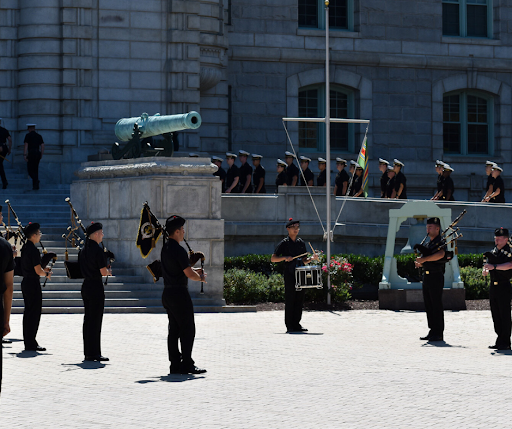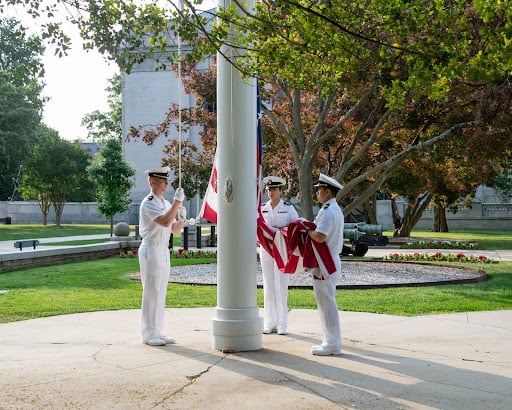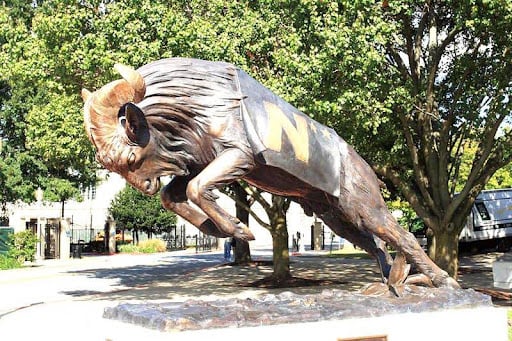Naval Academy tours are hands-down a must-do when you’re on the Yard in Annapolis. There are a variety to choose from, including the 90-minute Historical Walking Tour that covers many of the favorite spots, the USNA Tour & Tea, USNA Admissions Briefing and Walking Tour, the Jewish Chapel & Levy Center Tour, the GEM Car Tour, the Anchors Aweigh Music Tour, and so many more.
Sneak Peek
To get the best experience, you need to come here and see it for yourself, but we’ll give you a sneak peak at some of the amazing things you can learn on a Naval Academy tour! There are so many fascinating facts about USNA history, leading all the way up to today. That’s 179 years of history, with more being made every day. Are you ready to find out more?
Let’s get started!
How Did the Naval Academy Get Its Start?
Here’s the story: Army was here first! The area now known as the Yard was once Fort Severn, built in 1808. It was constructed across the river from Fort Madison and Fort Nonsense, all built to keep Annapolis and her harbor safe from the British and other adversaries. However, by 1845, Fort Severn was no longer needed, and the Navy acquired it from the Army for zero dollars.
How Big Is the Naval Academy Now?
Almost two centuries after its founding in 1845, USNA is rated number one in top public schools by U.S. News & World Report. It provides Bachelor of Science degrees in 27 different majors. There are about 600 faculty, and they are composed of about half military and half civilian employees. Approximately 4,500 midshipmen currently attend USNA.
Who Is Bill the Goat?
Bill XXXVII is Navy’s good luck charm and an important part of USNA history. There is a statue honoring the midshipmen’s famous mascot right across the way from the Armel-Leftwich Visitor Center. To the left of the statue, you can find a resting place for his ancestors, starting with Bill XXXIII.
What Is the N* Flag?
Right next to the Bill the Goat statue is the N* flag pole, which proudly displays Navy wins against Army. Varsity players here get a star to put on their “N” every time they beat Army, and Army also gives stars for wins over Navy. The pennants strung here count the wins over Army, with blue representing wins for men’s teams and gold for women’s. With 35 varsity sports in total, Navy has more sports than all other colleges except for Stanford and The Ohio State University.
Related: The History of the N*: An Epic Rivalry that Rolls On.
Where Do Midshipmen Train for Swimming?
Inside LeJeune Hall is the swimming complex, the wrestling room, and the athletic Hall of Fame room. In their first year, plebes (freshmen) must swim 200 meters (four laps) in less than five minutes, twelve seconds; third class midshipmen (sophomores) must swim 400 meters (eight laps) in less than eleven minutes and second class midshipmen (juniors) must swim 700 meters (fifteen laps) in less than 30 minutes—however they must do this in a khaki uniform with no shoes.
By the end of their second year, all midshipmen must jump from the top tower (ten meters) in a khaki uniform, feet first with no shoes into the diving tank, which is twelve to seventeen feet deep.
Related: USNA Notable Graduate Highlight: Roger Staubach.
Where Are the Heisman Trophies?
Navy is proud to have had two Heisman Trophy winners (so far). These replicas were gifted to the school by the Downtown Athletic Club of New York City and reside in the Football Hall of Fame display in LeJeune Hall. Roger Staubach and Joe Bellino, the winners, have their numbers retired (12 and 27, respectively) so they are immortalized in USNA history.
Related: USNA Hero Highlight: Joe Bellino.
Where Is USS ANTIETAM?
In Dahlgren Hall, there is a 52-foot-long, fully rigged model of a naval warship called USS ANTIETAM; it was built for the United States Centennial Exposition in Philadelphia in 1876, and it served as a way for midshipmen to “learn the ropes” before heading to sea.
What Is Captains Row?
“Captains Row” on Porter Road houses Naval officers with the rank of 06 - a captain or colonel. Faculty living here are department heads with two- to four-year tours. You’ll find the homes of the Dean of Admissions, Supply Officer, Senior Marine, Deans, Senior Chaplain, The Commandant of Midshipmen, and the Civilian Athletic Director here. When the Academy was being built, Porter Road was used as a canal to carry the large granite stones to build the incredible Ernest Flagg’s Beaux Arts buildings in the early 1900s.
Related: U.S. Naval Academy Captains Row: A Sneak Peek at Some of the Historic Homes on the Yard.
What Is T-Court?
Tamanend Court, or T-Court, is the place where the Academy was started on October 10, 1845, at the Fort Severn mess hall. To honor this beginning, plebes are sworn into the Navy here on Induction Day (I-Day) and also conduct Noon Meal Formation before their lunch in King Hall, just inside Bancroft Hall. The court is named for the Tamanend figurehead who oversees the space.
What Is Bancroft Hall?
Named for George Bancroft, Secretary of the Navy under President James Polk and founder of the Naval Academy in 1845, Bancroft Hall is one of the biggest dormitories in the world. It boasts 34 acres of floor space, 4.8 miles of corridors, and 1,800+ rooms. It’s a small city, with a barber shop and beauty shop, tailor shop, cobbler shop, Midshipmen Store, radio station, a post office with its own zip code, snack bar (Steerage Restaurant), medical and dental facilities, wardroom (King Hall) and access to the pistol range. King Hall can feed all midshipmen at every meal, serving more than 11,000 meals each day, and spanning more than 65,000 square feet, making it the largest dining facility in the world.
The Bancroft Hall rotunda retains its original marble floor from 1906. The buildings here were the first public institutions in the U.S. to have central heat and gaslights. And interestingly, Bancroft Hall was one of the first buildings in Annapolis to have electricity and rain baths (showers). As you enter Memorial Hall in Bancroft Hall, you can walk to the balcony. Across the Chesapeake Bay you can see Kent Island on Maryland’s Eastern Shore. This was where the first English settlement in Maryland, The Clairborne Settlemen was started in 1631.
What Is Preble Hall?
The USNA Museum, free to the public, houses the Rogers Ship Model Collection, a collection with a mind-boggling 108 ship and boat models that reflect the sailing ship era dating from 1650 to 1850. It’s one of the most valuable of its type in the world!
Want to Know More?
Hop on a Naval Academy tour! We are just scratching the surface of the many historical gems here at the Naval Academy. You can spend a day, week, or longer taking in all of the interesting stories. And when you take a tour, you’re supporting the midshipmen that support our freedom, since proceeds directly fund extracurricular activities like cultural arts, music, theater, club sports, and more. Come explore today and be a part of this amazing USNA history!
-1.png)










